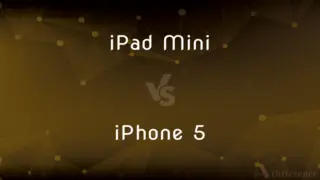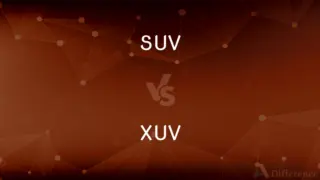Forward Engineering vs. Reverse Engineering — What's the Difference?
By Tayyaba Rehman & Urooj Arif — Published on February 4, 2024
Forward engineering is the process of building a system from specifications or design, while reverse engineering involves understanding or analyzing an existing system to replicate or enhance it.

Difference Between Forward Engineering and Reverse Engineering
Table of Contents
ADVERTISEMENT
Key Differences
Forward engineering is the traditional process of moving from high-level abstractions and logical, conceptual designs to the physical implementation of a system. It's a straightforward development from design to final product. Forward engineering often starts with a clean slate, developing systems based on predefined requirements or specifications.
Reverse engineering is the process of analyzing a subject system to create representations of the system at a higher level of abstraction. It often involves deconstructing software or hardware to understand its working, design, architecture, or to extract knowledge from the product. Reverse engineering can be used for software maintenance or to find flaws in the system.
In forward engineering, the development moves from concept, design, implementation, to testing. It's a linear progression in system development, often used in software development, architecture, and engineering fields. Forward engineering emphasizes creating systems from scratch, focusing on originality and innovation.
Reverse engineering starts with the final product and works backward to deduce design and implementation details. This process is commonly used in software development for compatibility purposes, in mechanical engineering to explore competitor products, and in cybersecurity for vulnerability analysis. Reverse engineering can be a learning tool, providing insights into the design process and decision-making of the original creators.
While forward engineering is about creating new systems, reverse engineering is about understanding existing ones. Both have their unique roles in the technology and engineering fields, with forward engineering being more about innovation and reverse engineering about analysis and replication.
ADVERTISEMENT
Comparison Chart
Direction of Process
Concept to Product
Product to Concept
Objective
Building new systems
Understanding/analyzing existing systems
Starting Point
Design and specifications
Existing product or system
Use Cases
New system development
Maintenance, learning, or replication
Emphasis
Innovation and creation
Analysis and deduction
Compare with Definitions
Forward Engineering
Involves implementing designs into physical form.
Engineers use forward engineering to construct a new type of vehicle.
Reverse Engineering
Used for replicating or improving systems.
Reverse engineering is employed to enhance older software systems.
Forward Engineering
Proceeds in a linear fashion from design to production.
The development of a new software application follows a forward engineering approach.
Reverse Engineering
Moves from product to design.
Cybersecurity experts reverse engineer malware to understand its construction.
Forward Engineering
Follows a structured development lifecycle.
Software developers use forward engineering to develop new applications.
Reverse Engineering
Involves analyzing and understanding current systems.
Engineers reverse engineer a competitor's product to understand its functionality.
Forward Engineering
Transforms designs into a tangible product.
Forward engineering is used to turn architectural blueprints into buildings.
Reverse Engineering
Helps in learning how existing products were made.
Students reverse engineer devices to learn about design principles.
Forward Engineering
Focuses on the creation of new systems.
Forward engineering is applied to create innovative electronic devices.
Reverse Engineering
Involves breaking down a system to study its components.
Engineers reverse engineer machine parts to find manufacturing flaws.
Reverse Engineering
Infl of reverse-engineer
Common Curiosities
Is reverse engineering legal?
It depends on the context and copyright laws; it can be legal for analysis and learning purposes.
What is the main goal of forward engineering?
To create new and innovative systems or products from designs or concepts.
What is forward engineering?
Forward engineering is the process of developing a system from design to implementation.
Can forward engineering be used in software development?
Yes, it's commonly used to develop new software applications.
Are there legal implications associated with Reverse Engineering?
Yes, there can be legal implications, especially if reverse engineering violates intellectual property or trade secret laws.
What is reverse engineering?
Reverse engineering is analyzing and understanding an existing system to deduce its design and operation.
Why is reverse engineering used?
For understanding, replicating, or improving existing systems and products.
Can reverse engineering be used for educational purposes?
Absolutely, it's a valuable tool for learning how systems and products are designed and function.
What is the role of documentation in both Forward and Reverse Engineering?
Documentation is crucial in Forward Engineering to guide the development process, while in Reverse Engineering, it aids in understanding the existing system.
Does forward engineering involve innovation?
Yes, it often focuses on innovation and creating original solutions.
What's a key difference in the starting point between the two?
Forward engineering starts with designs or concepts, while reverse engineering starts with an existing product.
Are Forward Engineering and Reverse Engineering mutually exclusive?
No, they are not mutually exclusive. Both processes can be used in different phases of a product's lifecycle.
Share Your Discovery

Previous Comparison
iPad Mini vs. iPhone 5
Next Comparison
SUV vs. XUVAuthor Spotlight
Written by
Tayyaba RehmanTayyaba Rehman is a distinguished writer, currently serving as a primary contributor to askdifference.com. As a researcher in semantics and etymology, Tayyaba's passion for the complexity of languages and their distinctions has found a perfect home on the platform. Tayyaba delves into the intricacies of language, distinguishing between commonly confused words and phrases, thereby providing clarity for readers worldwide.
Co-written by
Urooj ArifUrooj is a skilled content writer at Ask Difference, known for her exceptional ability to simplify complex topics into engaging and informative content. With a passion for research and a flair for clear, concise writing, she consistently delivers articles that resonate with our diverse audience.














































